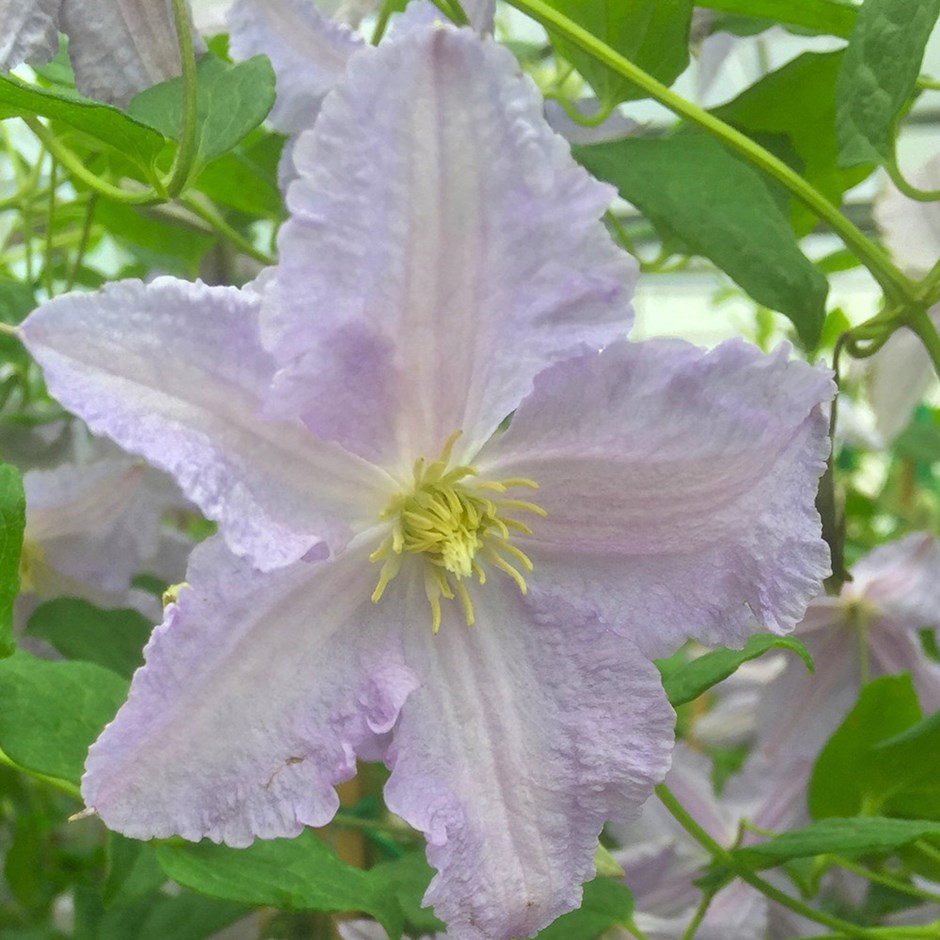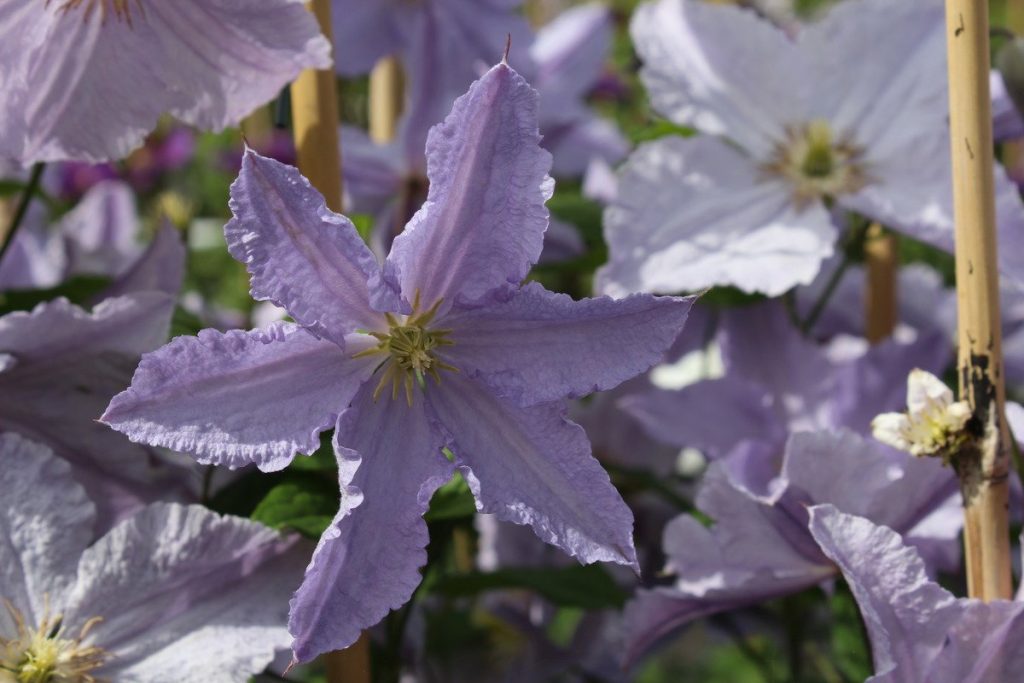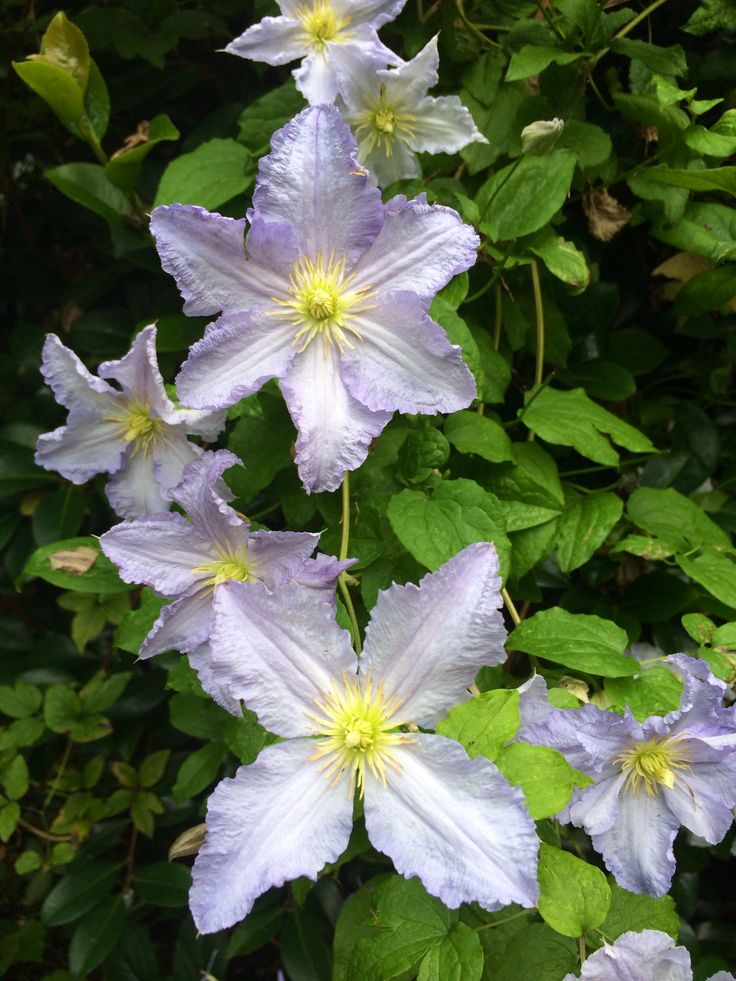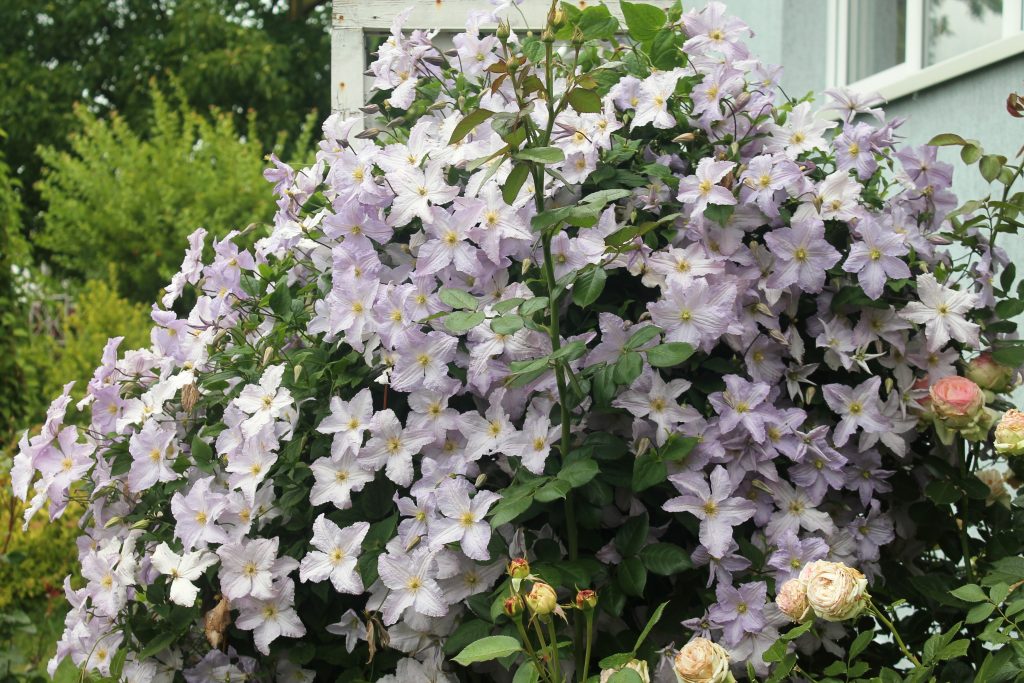Clematis Blekitney Aniol - general information about the variety
Clematis Blekitny Aniol is a popular decorative perennial with creeping stems. It was bred in 1987 by the famous Polish breeder Stefan Franczak. The name of the variety is translated as "Blue Angel". In Europe it is known as "Blue Angel".

Clematis blekitny aniol
Description of the variety
Blekitny Aniol is a vigorous perennial from the Buttercup family. Creeping stems grow up to 3-4 m in length.
Long bloom: from the second half of June to early September. Flowers appear on the shoots of the current year.
- The leaves are trifoliate (with petioles capable of clinging to the support).
- Flowers - lilac-blue, with a diameter of 8 to 15 cm.
- The petals are elliptical in shape with a narrowed tip and wavy "openwork" edges.
- The middle is yellow-green.
Landing features
Planting is carried out in spring or autumn - a month before the onset of cold weather.
Closed-rooted specimens can be transplanted in summer.
The seedlings are pre-soaked in water and disinfected.
The place is chosen in light partial shade or in the sun with midday shade. It must be reliably protected from the wind. The plant is suitable for soil with a neutral, slightly acidic or slightly alkaline reaction, preferably loose and fertile.
Clematis should not be planted in a place where groundwater is close, accumulation of rain or melt moisture.
Technology:
- Dig a hole 60 cm deep and wide.
- A drainage layer of small stones, gravel or broken brick is laid on the bottom.
- The soil is mixed with humus and wood ash, sand and complex fertilizers are added.
- The substrate is poured with a mound, the seedling is placed on top, and the roots are laid down on the slopes.
- Pour a bucket of water.
- The remaining soil mixture is poured, deepening the root collar by 8-10 cm, and tamped.
- Support is established and the stems are tied up.
- Water again.
- Mulch the soil with pine bark.
Care
Blackitney Aniol needs the most basic care. He needs regular watering and feeding, mulching the soil, tying to a support. Every autumn, the stems are pruned and clematis is prepared for winter.

Clematis blacketney aniol description
Watering
After planting, the plants are watered twice a week (6-8 liters per bush). Adult vines are watered less often, but more abundantly: once every 10-14 days, using 15-20 liters of water.
In this case, you need to focus on the weather and the presence of natural precipitation. The soil should be moderately moistened, but not kept moist all the time, which can cause fungal diseases.
Top dressing
In the first year, the plant does not need to be fed. In the future, fertilizers are applied 3-4 times per season, alternating organic matter with mineral complexes. Since August, only phosphorus-potassium fertilizing is carried out.
Mulching
The soil around the bush is mulched with a layer of 8-10 cm, protecting the roots from overheating. Pine bark, peat chips, hay, needles, dry compost are used as mulch.The procedure will greatly facilitate maintenance by suppressing weeds and reducing moisture evaporation.
Garter
Liana needs a garter, as thin stems can break from strong winds. Immediately after planting, the stems at the bottom of the bush are tied to a support. In the future, the shoots are tied up as they grow, with a fan.
Pruning
Clematis flowers grow on the shoots of the current year, which corresponds to the pruning of the third group. It is carried out in the fall before the shelter of the bush for the winter.
Technology: with a disinfected pruner, the stems are cut almost to the base, leaving 1-2 buds or 15 cm in length.
Preparing for winter
Blekitney Aniol is a winter-hardy plant, but it needs preparation before winter. A pile of earth 10-15 cm high is poured under the bush so that the roots do not flood when the snow melts. Top covered with spruce branches or dry foliage. Additionally, you can cover it with a wooden box.

Clematis blacketney aniol reviews
Reproduction
Clematis are propagated by rooting cuttings, dividing the bush and layering.
Seed propagation does not preserve the varietal characteristics of the plant. Most often, gardeners use cuttings.
Cuttings
The stalk is cut with one knot and two leaves. One leaf can be removed to reduce the evaporation area.
The rooting substrate is prepared from two layers:
- on top - coarse wet sand;
- below - fertile disinfected soil.
The cuttings are deepened, and the container is covered with foil or glass for the greenhouse effect (the greenhouse is ventilated every day). The time of appearance of the roots is determined by the awakened buds.
Dividing the bush
It is advisable to apply this method no more often than once every 5 years. The bush must be dug up and divided with a shovel into several parts (with at least one bud on each).
Then you should choose a place in partial shade, dig up the soil with ash and compost. Delenki are planted in the usual way and watered twice a week.
Layers
The soil near the bush is dug up, loosened, watered well. On the selected stem, the leaves are cut off and the nodule is bent to the ground. Fix the shoot with a staple or wire, sprinkle with sand, moisten. Rooting of the cuttings takes place within 1-1.5 months.

Clematis blacketney aniol photo
Diseases and pests
| Problem | Signs | Prophylaxis | Wrestling |
| Aphid | Bugs on the back of the leaves. Leaf plates dry, deform, change color. | Fighting anthills dangerously close to clematis. Planting calendula (to attract ladybugs - natural aphid exterminators). | Cut off the twisted leaves, rinse the bush with a solution of tar soap and alcohol. Spray with Fitoverm. |
| Powdery mildew | White "flour" bloom, darkening of the stems, stunted growth. | Moderate watering, disinfection of drainage and garden tools. Preventive soil treatment with manganese and ash solutions. | Cut off the affected parts of the plant. Treat clematis with copper sulfate or Topaz fungicide. |
| Wilt | Loss of turgor of leaves and shoots. Withering and drying out of the bush. | The correct watering and feeding regime (do not exceed the rate of nitrogen fertilizers). Disinfection of garden tools. | Trim off affected stems to the base and burn completely. Treat the rest of the plant and soil with Fundazol. |
Gardeners reviews
According to gardeners, Blekitny Aniol clematis grows well outdoors or in a large container. Flowering is abundant and long lasting. It is noticed that the shade of the petals in different plants varies from lilac-blue to pinkish. According to some growers, this depends on the growing conditions and the acidity of the soil.

Clematis blacketney aniol photo
The advantage of the variety is considered to be easy maintenance and an understandable way of pruning. Liana tolerates winter well, but even if it freezes, it quickly recovers. For many gardeners, clematis blooms in the first or second year after planting, delighting with abundant flowering along its entire length.

